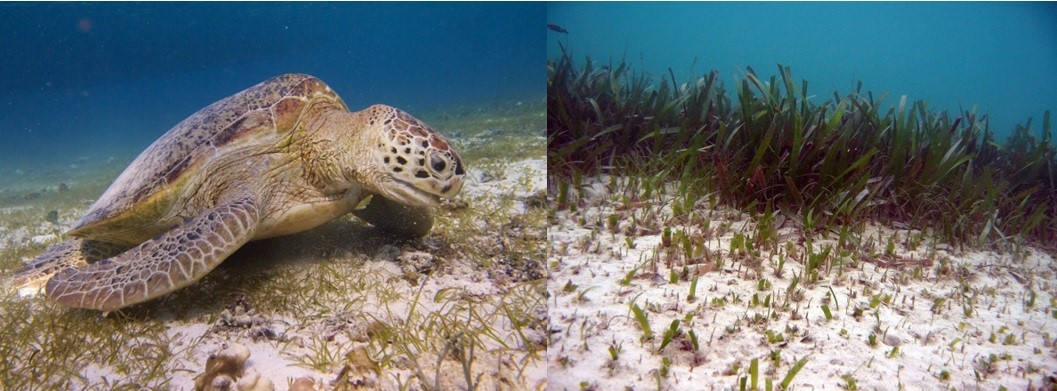12-04-2021
New perspectives for the conservation of seagrass meadows and green turtle populations
Photographs: Marjolijn Christianen / Brigitta van Tussenbroek
Barcelona, April 12, 2021. Conservation efforts in recent decades have facilitated a remarkable recovery of some green turtle populations in different parts of tropical seas around the world. However, in these places overgrazing caused by these chelonians is threatening seagrass meadows and could even generate underwater 'deserts', according to an article published in the journal Nature Ecology & Evolution with the participation of researcher Jordi Pagès, from the Faculty of Biology and the Institute for Biodiversity Research of the University of Barcelona (IRBio), and also a member of the Center for Advanced Studies of Blanes of the CSIC (CEAB-CSIC).
The voracity with which large aggregations of green turtles (Chelonia mydas) -an eminently herbivorous species with a global distribution in tropical and subtropical waters- act would require a review of the current conservation and management models of these marine grasslands to avoid a process of progressive 'overgrazing'. The work is led by researchers Majolin Christian, from Wageningen University, and Marieke van Katwijk, from Radboud University (The Netherlands), with the participation of researcher Teresa Alcoverro (CEAB-CSIC).
From savanna to underwater forest: new perspectives in ecology
Underwater meadows are made up of species of marine phanerogams that generate a habitat of great ecological value (food, shelter, reproduction, coastal protection, etc.) that is key to conserving marine biodiversity. In these complex ecosystems, sea turtles feed and generate a dynamic mosaic landscape with leafy and bleached areas that reveal different stages of grazing.
The paper argues that pre-Anthropocene large seagrass meadows would have been heavily grazed by large marine herbivores such as green turtles, making these habitats more like a 'savanna' than an 'underwater forest'. The paper also emphasizes the misconception of considering forests as 'virgin' systems and savannas as 'degraded' systems.
savannas as 'degraded' systems. Thus, a marine forest consisting of dense, undulating grasslands filled with long-leaved phanerogams would be no more natural than a landscape of densely vegetated areas interspersed with patches grazed by sea turtles.
"On land, we have long since begun to abandon the idea that a savanna is a degraded state of a forest to highlight the fact that some ecosystems - such as savannas - are naturally under more pressure from herbivores or fires," says Jordi Pagès, who is a Marie Sklodowska-Curie researcher in the Ecology Section of the Department of Evolutionary Biology, Ecology and Environmental Sciences of the UB and IRBio_UB.
"In the marine environment," she continues, "preanthropocene seagrass meadows were probably less lush and more heterogeneous than we thought. This particularity is not negative in itself but it would imply certain environmental costs in the form of loss of ecosystem services."
"However, what must be avoided is excessive overgrazing that would lead to the disappearance of seagrass meadows, since the process of recovery and restoration of seagrass habitats is, in general, very unsuccessful. If it comes to this extreme, the loss of the services provided by seagrasses is irreparable," warns the researcher.
"Seagrasses change due to grazing," details researcher Marieke van Katwijk. "But if grazing continues for too long, seagrass meadows become extremely vulnerable and even a very small storm could wipe them out."
Preventing seagrass meadows from disappearing
This new perspective put forward by the research team would require a change in the environmental management model in these marine areas. "There is a potential conflict between the effort to conserve a marine ecosystem that generates optimal ecosystem services for humans - coastal protection, food production, etc. - and the conservation and recovery of populations of such charismatic animals as sea turtles," says researcher Marjolijn Christianen.
To solve the dilemma, the team proposes to accept the partial loss of the ecosystem services of large seagrass beds without ever leading to their disappearance or total loss. "It should be remembered that despite the conservation successes of the large populations of green turtles found in some parts of the world, on a global scale turtle populations continue to be subject to many pressures. As successes multiply, perhaps we will have to accept that seagrass meadows with megaherbivores will be less lush and more heterogeneous than meadows where megaherbivore populations have disappeared," concludes researcher Teresa Alcoverro (CEAB-CSIC).
